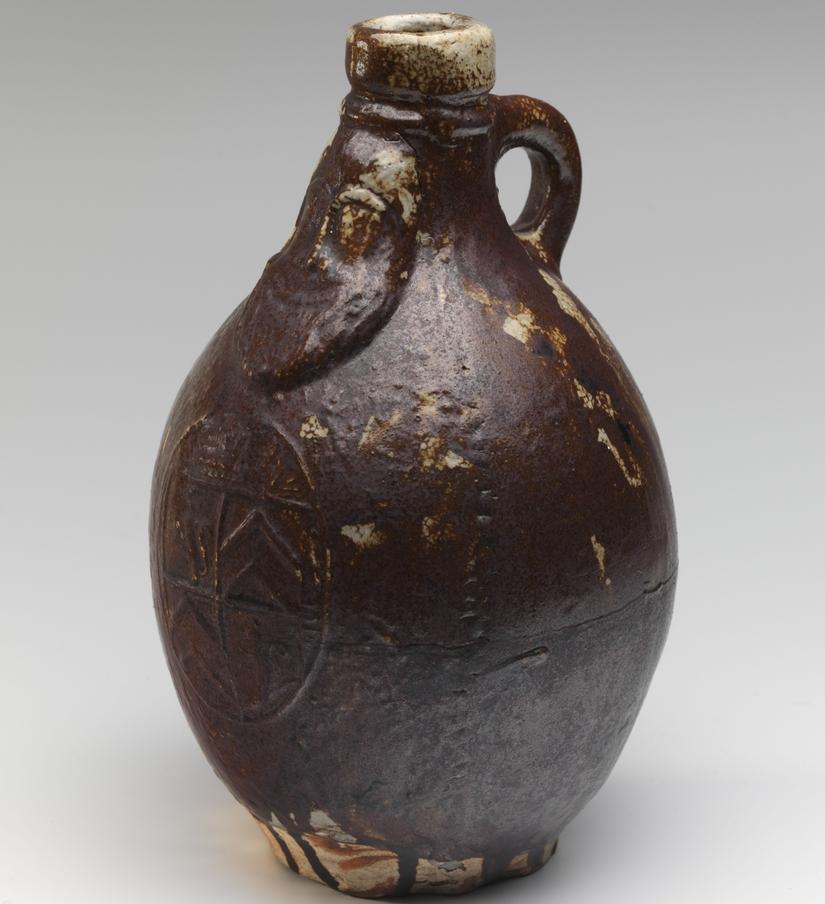It is likely that during the 17th and 18th centuries, the Dutch East India Company (Vereenigde Oost-Indische Compagnie, or VOC) shipped thousands of stoneware Bartmann jugs filled with spirits, in particular genever (Dutch gin), to Southeast Asia, including Japan. The VOC ordered these jugs from potters in the town of Frechen in Germany. They reached Japan through the Dutch trading post on Dejima, a small, artificial island in the Bay of Nagasaki, and became known in Japanese as “Higedokkuri”, meaning “beard sake bottle”. From 1641 to 1854, the Dutch were the only European power allowed to trade with Japan, but their presence was strictly limited to Dejima after the Portuguese, who were the first European power to trade with Japan, had caused much trouble through their missionary activities and were expelled.
During the 18th century, Japan slowly started to open up to the Dutch and their goods, and ‘Dutch things’ became fashionable in Japanese society. The Bartmann jugs, with their anthropomorphic mask of a bearded, wild-eyed “southern barbarian”, evidently caught the imagination of some Japanese, because they were incorporated as curiosities in that most Japanese of cultural activities: the tea ceremony. The ceremony often includes a simple dinner ("Kaiseki"), accompanied with sake. The host leaves a “Tokkuri” (sake bottle) for the guests to enjoy while he prepares the meal, a custom called "Azukedokkuri". A special vessel is often used for this purpose, something that the guests could enjoy talking about, as Azukedokkuri is understood to act as the host's substitute in his absence. The Bartmann jug must have been quite perfect for this purpose.
During the Edo period in the 19th century, a number of Japanese potters actually started to make imitations of these Bartmann jugs. The reason is unknown, but it is likely that by that time the original jugs from Germany, now from a century of more ago, were increasingly hard to find. Some of these imitations closely follow the ones from Frechen, while others are much freer interpretations, displaying the creativity of the potters who were interpreting this exotic object. Potters such as Aoki Mokubei (1767-1833) in Kyoto, Nin’ami Dohachi (1783-1855) at the San kiln in Kagawa, as well as the Yanagihara kiln in Kurume, Fukuoka and possibly the Shiga kiln in Tsushima, Nagasaki, are known to have made these imitations, but for most jugs the makers have as of yet to be identified.

Image: Japanese Bartmann jug, stoneware, maker unknown, c. 1700-1850, collection number: F 9318 (KN&V), Collection Museum Boijmans Van Beuningen, Rotterdam / Photography: Tom Haartsen.
Practically unknown until recently, are the Japanese Bartmann imitations found in Indonesia. These make it likely that there was a second, more prosaic, demand for the jugs: not the revered tea ceremony, but as sake containers. Sake, together with other Japanese goods such as soja, rice, baskets, and large stoneware water jars called Martabans in contemporary cargo lists, was a staple on ships leaving Dejima for the Indonesian archipelago during the 19th century, and may have been imported as a replacement of or competitor to the Dutch gin imports. A rumor even has it that several of these jugs were found in a shipwreck off the coast of East Java. As the Bartmann jugs from Frechen had been used to ship gin, the familiar jugs with their bearded mask likely indicated the alcoholic contents to the consumer of the beverage.
These jugs from Indonesia are on average larger than the ones made for tea ceremony, but very little is known about them otherwise. One particular type has tentatively been attributed to the Agano kiln in Fukuoka, based on the resemblance with wares from that kiln. An impressed potter's mark on one of those jugs consists of the Japanese character for “Osama “, which means “King”. This could refer to the potter, but it is also possible this is a reference to another name under which Bartmann jugs were known in Japan: “Omen”, meaning “King mask”.
Acknowledgements: thanks to Gen Mitsuishi, who kindly helped identify and translate Japanese sources on the topic.